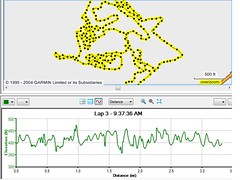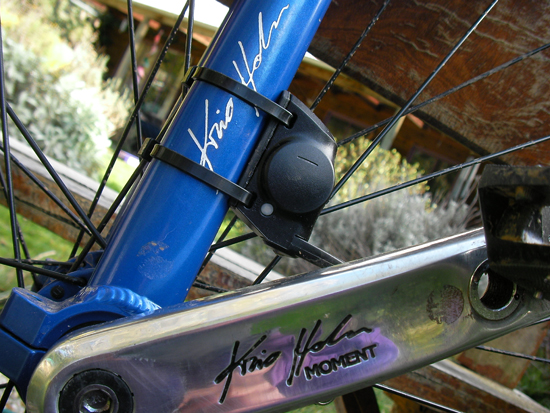Wow, another veteran poster resurfacing from the past.
ftfy.
[/QUOTE]
Yeah, I remember when we all used to call Greg “The White Whale” because he was such a huge Harp-goon. Good times.
billnye
John M
I agree, at this point I think I spend little energy on balance. However, there is some focus to keep the balance, I found myself really focusing on the road at RTL to look out for bumps that could throw me off. I noticed this more with my 29guni than my 36guni. I feel more stable on the 36guni…but have also now been riding longer.
ro
I agree that the GUni takes more attention. For me, I think that’s mostly because balance errors have serious consequences, and are harder to recover from than on an ungeared uni; after you take a couple high-teens falls, you pay extra attention to the road.
Muni experiment - the Camelback Effect?
I took advantage of a local mountain bike race today to test wheel sizes off-road. This is a 2hr race, 3.3mi laps, I usually end up doing 4 laps with a lap time around 35min. The course is ‘semi-technical’. It has lots of small and medium hills (~900ft total climbing), a crapload of curves, a fair amount of roots, and a dozen or so obstacles to get over (logs, wood planks, etc…). Here’s a map an elevation profile.
Making muni comparisons is complicated by the variability in riders skill and in course difficulty. However, I would suggest that some indication of rough number of UPD’s a rider typically makes on a course with a 24" unicycle is a good index to help compare. In this case, for me, I probably fall ~10 times per lap on a 24. I’ve ridden the course a lot, and have made every obstacle except one at least one time, but never strung together one perfect lap. So my wheel-size results here are probably roughly comparable to some course you ride with a 24" and get ~10upd’s.
I rode a kh36 (165mm cranks), then a kh29 (150mm), then a kh24 (150mm), then my last lap back on the kh29. Overall the KH29 had the best lap times and average speed, although the three wheels were actually surprisingly close in their average speeds for the lap (5.3-5.7mph), which works out to 2-3min difference per lap. [note I started my gps a bit late on lap 1]
The 29er was best because it was still agile enough to get over most of the technical bits and also fast enough to take advantage of the zoomy sections. The 24 was roughly equal on the technical sections (but not completely, see below) but felt very slow on zoomy sections. The 36er went fast some times, but was very difficult on the sections of trail that went up and down and up and down the hills, resulting in 21 total upd’s.
In my first lap I really pushed myself hard, I was riding with some mtb’ers, passing and getting passed, and was jazzed to be going fast on my 36er so I didn’t hold back - somehow exceeded my ‘maximum heart rate’ according to Garmin, and spending most of the lap up around 95% heart rate. Maybe not the best strategy for lap1. My legs were shot at the end of this lap and I still had 3 more to go. The 29er let me stay more in the 90-95% range, while the 24 was a bit lower. Exertion wise, I’d put the 36er as too much, the 24 as too little, and the 29er as just right - for this course.
The Camelpack Effect? I was a little surprised I didn’t have fewer upd’s on my 24", but figured it was because I was tired as it was my 3rd lap. So I jumped on my 29er for the last lap to see how many more upd’s I would have than I did on my 2nd lap. To my surprise, I had 1/2 as many. I was really nailing the course, it was fun, and ended up being my fastest lap.
No way my last lap should be the fastest, with fewest upd’s! The only other difference was that I didn’t wear my camelpack on this last lap. I drained it in a break between laps 3-4 so took it off. Does a camelpack really increase your UPD’s by a factor of 2? I figured it would have some minor effect, but not this much. Anyone else noticed this?
-Ro
You had fewer UPDs on each lap; a lot of the effect is surely just knowing the course better.
Certainly I’ve had UPDs that were at least partly caused by a backpack, especially when it’s heavier than I’m used to riding.
camelpack effect
I find that a camelpack affects me a lot more if I don’t have the wast strap on.
Ever since my crash in 07 I have not done much riding with anything larger but I think that how secure the pack is is more important than how heavy it is. I tend to tighten the straps throughout a ride as the bladder deflates.
There is some great info on this thread so far ![]()
rolandisimo,
Nice write-up!
Would you list crank sizes and tire type for the three unicycles you used in the race?
I am sorry, I see you have the crank sizes listed. I was mainly curious about crank size on the 29". What tire did you use on the KH 29"?
I don’t think being more familiar with the course had that much to do with it, I’ve ridden the course about 10times before. The camelpack does have a waist strap. My older camelpack didn’t, and it was a big pain always flying up over my head when I’d hop. Its a 2L pack, not huge, but not small.
I’ll have to go do another muni ride and count upd’s with/without the camelpack to see if this is for real.
-Ro
Very interesting thread!! But will need some time to peruse all those data - and that’s time I don’t have now. For some time I’ve had an idea to create a spreadsheet that ‘predicts’ your max speed at a certain TGR depending on a couple of additional things/thresholds.
Wow, AccordNSX is still alive! But I think the “closest second” was Frank Bonsch in Germany - he finished his geared hub just days after Harper’s first prototype.
Just a little detail: you’ve got your TGRs correct, but the correct crank lengths are 165 and 137 mm. The only reason I point this out is for other nerds who want to verify the calculations or somehow analyse your data.
That would be interesting - what ‘things’ would you include?
Options include:
- fear of (falling at) speed: hold back as speed increases, not at low speeds
- gear slop: x % holdback if gear
- gear frame reactions
- output power: holdback as function of speed, not at low speeds
- max cadence: holdback as cadence approaches max cadence
- efficiency of cranks: holdback as crank length deviates from ideal
Does anyone use the 305 cadence sensor?
I’m so out of it I’ve been using the 305 for 3 years and didn’t even know (remember) that it supported a wireless cadence kit. How cool! I would be curious if anyone has tried it too.
305 Edge or Forerunner
Is it only the GarminEdge 305 that has the cadence sensor? I’d like to see a photo of the mounting for the Edge 305. How does it take to UPDs? Perhaps the Klaas Bil helmet mounting is safest.
The Cadence sensor works with both the Edge 305 and the ForeRunner 305: http://shop.garmin.com/accessory.jsp?sku=010-10644-00
Garmin’s GSC 10 speed and cadence sensor is listed as an accessory for quite a few of their cycling/watch GPS gadgets. I’ve used one with my 405 watch, picture of it mounted on my 29’er uni attached from my blog post on it
http://unplannedismounts.com/2009/04/21/garmin-405-gps-watch/
The GSC 10 unit is quite large which is a bit of a bummer. The mounting system isn’t great and there’s also a longish adjustable arm that comes out of the unit for the wheel/speed sensor. Combine all those things and to me anyway it seems prone to being damaged e.g. fed into the wheel during a UPD.
http://www8.garmin.com/manuals/1137_GSC10ReferenceGuide.pdf
Also due to the deep channeling in the back of Moment cranks, their q factor and how the pedal/cadence magnet fits a home made spacer is needed
I ended up taking the GSC 10 off the 29’er last year with the intention of fitting it to the 36’er GUNI, gotta get around to doing that (with a modified mount) as I think the data would help track my progress on the GUNI.
Have to say too, great thread!
I’ve fitted the GSC10 cadence/speed to my GUNI, thanks to this thread for getting me off my butt on that project ![]()
Here’s a snippet of some data from the a quick test ride around a dirt loop, mainly flat but with a couple of small hills.
Not too many surprises there, laps of the loop in 1:1 gear were:
* Significantly slower speed vs 1:1.5
* Higher average cadence vs 1:1.5
* Less variation in speed and cadence vs 1:1.5
What it doesn’t capture of course is the subjective experience of riding. I find it much more enjoyable, though more difficult, to ride around the loop in 1:1.5 vs spinning away in 1:1.
Hope to fit in some longer rides this week on the GUNI, will be interesting to see the data.
Some more notes and pics at
http://unplannedismounts.com/2009/05/19/speed-and-cadence-revisited/


